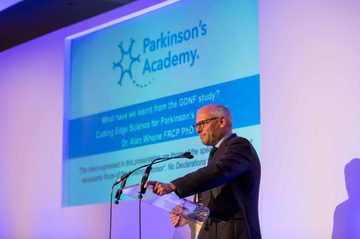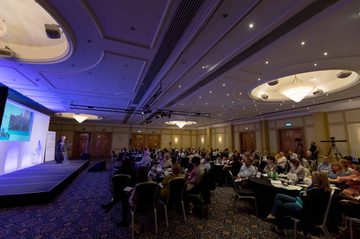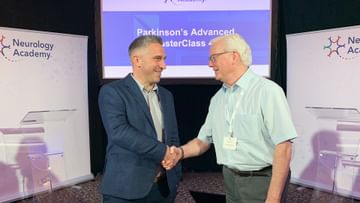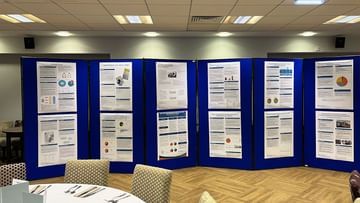What have we learnt from the GDNF study?
Event reportsBack in June the Parkinson’s Academy hosted “Cutting Edge Science for Parkinson’s Clinicians”, an educational meeting sponsored by Bial Pharma. Now in its second year the meeting was a sell-out again and expectations were high. Chaired by Dr Peter Fletcher(Gloucestershire Hospitals NHS Foundation Trust), the meeting was designed to cater to the diverse needs and interests of its varied audience of neurologists, care of the elderly physicians, psychiatrists and Parkinson’s nurses.
This year, the meeting’s theme was to ‘Question everything’, to review what we already know, and to think about how clinical observations and cross-team collaborations can drive us forward. Each week we are posting an article to look at the meeting’s speaker sessions in more detail.
Dr Alan Whone opened his presentation of the pioneering GDNF study by answering the question posed –
Although the study did not meet its primary endpoint,1 many interesting findings can be realised in the data, and it would be wrong to view this study as a failure.

First off, this was the first randomised clinical trial in PD using an innovative delivery mechanism to administer a neurotrophic factor to the putamen. Professor Steven Gill designed the pump to deliver GDNF in pulses to enhance convection delivery. Each putamen received 800μL of study drug which PET scans confirmed affords spatial delivery of GDNF sufficient to achieve biological effect across the entire putamen. The delivery route from the back of the head (rather than coming down from the top of the top of the head as in DBS) was also specifically chosen to allow for better putaminal coverage. Dr Whone went on to note that many drugs cannot reach the brain due to the Blood-Brain Barrier. The system was shown to be safe over 80 weeks, which opens the door for other medications that can be used to combat brain diseases. The device is now being used in two new trials; one evaluating cerebral dopamine neurotrophic factor (CDNF) and one for children with brain tumours.
Additionally, the drug was safe, with 99% compliance for infusions, paving way for further research. No patients dropped out and only 3 infusions (out of >400) were missed in the first 3 months. This may have been due, in part, to the incredible sense of hope the patients described. All patients understood they may not be in the active treatment group, but they said they felt like contributing pioneers of research. Dr Whone added that the trial, and the efforts put into recruiting and properly explaining the trial to potential trial candidates, really brought home what providing informed consent really means in practice. All patients went through what became a 4-hour interview.

While there were some encouraging signs of improvements in those receiving GDNF, there was no significant difference between the active treatment group and those who received placebo on any assessments of PD symptoms in the nine month trial.1 However, a number of participants felt that the therapy had beneficial effects. Results from brain scans also revealed extremely promising effects on damaged brain cells. After nine months, there was no change in the scans of those who received placebo, whereas the group who received GDNF showed improvement ranging from 25% (left anterior putamen; P = 0.0009) to 100% (both posterior putamina; P < 0.0001).1Dr Whone noted that the magnitude of the improvement in PET scans exceeds all previous studies, and keeps alive the hope that we may have a means to possibly reawaken and restore the dopamine brain cells that are gradually destroyed in PD. He discussed that the failure of GDNF treatment to produce the same effect on symptoms could be for a number of reasons including the study duration and study dose. For example, it may be that symptomatic benefits lag behind the improvement in the brain scans, and a longer trial may have produced a clearer effect. This was indeed the case with some patients who received foetal cell transplantation in previous trials. Dr Whone noted that further developments in the port technology will also allow exploration of dosing and frequency, and toxicology indicates that a higher dose can be trialled.
Dr Whone ended his presentation by addressing the issue of subgroups, while the differences in clinical outcome between the GDNF and placebo groups were statistically indistinguishable, there was a relatively large variation in response; nine patients in the GDNF group, but none in the placebo group improved by more than 35%, although some did not improve at all. Understanding which patients responded best will be an important step forward. It may also be that the clinical endpoint chosen (UPDRS motor scores) was not the best outcome and the use of combined endpoints may allow for a reduced placebo effect. Finally, Dr Whone looked forward to the use of wearable technologies to enable better understanding of the ecological impact of treatment on activities of daily living.
References
- Whone A, Luz M, Boca M, et al. Randomized trial of intermittent intraputamenal glial cell line-derived neurotrophic factor in Parkinson's disease. Brain 2019;142(3):512-525.

This meeting was designed and delivered by the Parkinson’s Academy and sponsored by Bial Pharma. The sponsor has had no input into the educational content or organisation of this meeting.
Related articles
'The things you can't get from the books'
Parkinson's Academy, our original and longest running Academy, houses 22 years of inspirational projects, resources, and evidence for improving outcomes for people with Parkinson's. Led by co-founder and educational director Dr Peter Fletcher, the Academy has a truly collegiate feel and prides itself on delivering 'the things you can't get from books' - a practical learning model which inspires all Neurology Academy courses.






